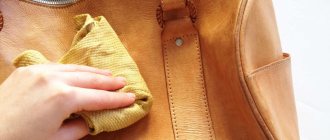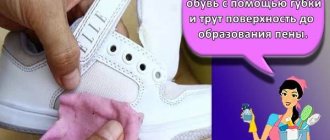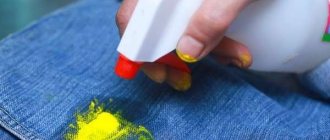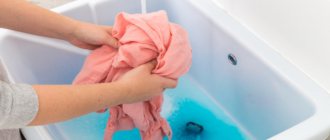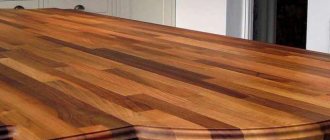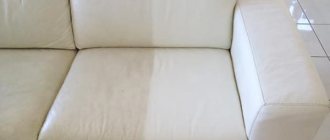The material bitumen is used in construction, repair and construction of roads. Contamination of clothing and shoes with it occurs in the hot summer, when the asphalt melts and if you walk on it, it clings to the sole and sides of the shoe. Its particles fly from under the wheels of cars and stick to our things.
If you see a tarry substance on your clothes, you need to immediately clean it, because over time it will cut into the fabric or skin even more strongly. It is important to know that bitumen cannot be washed; it does not dissolve in water and simply spreads across the fabric. It is impossible to remove it by combing, because the surface of the material can be damaged.
If your clothes are heavily soiled with it, you should try to remove it with your hands or scrape it off with a knife. Freezing the item helps some, while heating it for others helps. Sometimes bitumen freezes and becomes so attached to the threads of the fabric that it is impossible to clean it. After freezing, bitumen becomes brittle, easily breaks into pieces and comes off clothes.
After mechanical removal of bitumen parts, we proceed to chemical cleaning with gasoline, white spirit, kerosene or acetone-based solvent. Gasoline is better than acetone for removing bitumen stains. Apply a soap solution around the stain to prevent it from expanding. The solvent is applied to a cotton pad and applied to the fabric for 2-3 seconds and the bitumen is wiped off the clothing. After this, the item is washed following the instructions listed by the manufacturer on the label. Do not leave the solvent on clothes for longer, so as not to harm the fabric.
How to remove bitumen stains?
From such things, in addition to solvents, fresh bitumen can be easily cleaned with sunflower oil. Soak a cotton pad in it and wipe off the stain. After removing bitumen from the surface of the skin in this way, an ingrained dark mark may remain; its removal must be done using a cotton cloth soaked in alcohol.
Interesting materials:
How to replace a floral sponge for fresh flowers? How to replace glycerin at home? How to replace disposable dish sponges? How to replace Punto Switcher? What to cover the stairs with? How to lay the floor under linoleum? How does an actor live at the bottom? What is the Alexandria Lighthouse famous for? What is Kutuzov famous for briefly? What is Nietzsche famous for?
What influences the choice of cleaning method?
The easiest way to wipe off tar from the surface is with organic solvents. It can be gasoline, white spirit, acetone. However, these products are quite aggressive and cannot be used for all types of shoes.
- Genuine Leather. Shoes or boots made of genuine leather should be treated with organic solvents only in cases where milder methods of exposure have not yielded results. These substances dry out the skin, which causes deformation. Therefore, solvents should be applied locally only to stains, and then the natural leather should be wiped with Vaseline or castor oil to soften the material.
- Artificial leather substitutes. Shoes made from artificial materials cannot be treated with aggressive substances, as they will destroy the coating. Alcohol solutions can be used.
- You need to be very careful when cleaning patent leather. Most products are not suitable for this material. It is allowed to use ammonia solution.
- Textile shoes can be cleaned with any solvent, but first you need to make sure that the chosen product does not discolor the material.
Household chemicals
Household chemicals that help remove traces of bitumen or tar can be purchased at a car dealership. They sell products in the form of sprays for cleaning the body. They act effectively, but quite gently, preserving the paint layer.
You can use these products on any type of shoe, but first you need to test the product on an inconspicuous area. This will ensure that the material does not discolor or deteriorate after contact with the cleaner.
Textile shoes can be treated with clothing stain removers. For example:
- Beckmann Grease and bitumen
- Taygeta S-405
- Super Degreaser and others.
Use the stain remover strictly according to the instructions.
Cotton and linen
How to clean bitumen from cotton or linen clothes depends on the complexity of the contamination. With fresh prints, ammonia will help, which is used to treat the mark, and then the product is washed with a powder enhancer. Washing in hot water with caustic soda can remove bitumen from cotton fabric.
Stubborn stains can be successfully removed with solvents, and they can be safely used on linen and cotton items. The print can be dissolved with white spirit or kerosene, RW-40 or gasoline. The main thing is not to overuse the cleaner so that the fabric does not become thin.
Removing bitumen from clothes made from natural materials
Contaminated leather items or a bag can be easily cleaned. Genuine leather should be cleaned without problems. You will need a damp cloth for this purpose. Vegetable oil will help in cleaning bitumen from the skin.
The same cannot be said about suede material or faux leather. The tar spot may disappear, but another one will appear; the skin may change color.
It is not difficult to clean bitumen from clothes made from natural fabrics such as velvet, calico and satin. Any product containing benzene will do. Do not get carried away with the amount of solvent so as not to spoil the fabric. After applying it to the fabric, you should wait a few moments and watch its effect. If the stain has disappeared, a second application is not required. If it's fresh, then Vanish stain remover will help.
How to clean. It happens that an item is very contaminated with bitumen mastic. First, we carry out mechanical cleaning with a knife, cutting off very carefully those pieces that can be cut. We take a glass jar and place the item with the stain face down on it, stretching it a little. Under the stain we place a clean cloth folded several times, the soft fabric of which absorbs liquids well. Apply solvent to the stain. For convenience, you can take a syringe, about twenty cubes, so that you don’t have to fill it often, and we begin to apply the product to the stain. The resinous substance dissolves and goes into the cloth, which needs to be moved if it has absorbed a lot of liquid. Do this until it dissolves completely. Next, we wash the item, adding washing powder, rinse well and dry. It may happen that the stain will not go away completely, but it will become much less visible. Can also be washed by adding stain remover.
Cleaning products . Yellow stains that appear when washing bitumen from clothes from using gasoline or kerosene are removed with hydrogen peroxide.
On linen or cotton fabrics, it is better to use purified gasoline or solvents such as 646, 464, 650, which clean bitumen very well. Don’t forget to lubricate the fabric around the stains with soapy water to prevent further spreading of these stains.
Bitumen stains on items made from natural fabrics can be removed with butter. Cut a piece and rub it into the stain until the oil darkens. We do this several times. The spots should disappear and become invisible. Such items must be washed by hand with laundry soap.
The products that motorists buy to clean their cars from the same problem will help wash bitumen from clothes made from natural fabrics.
Preparation
To remove resin stains faster and more effectively, things need to be prepared. The structure of resinous substances is quite complex, so it is not possible to simply wash them off.
Main stages of preparation:
- If the stain is convex, that is, there is quite a lot of resin, then first try removing it mechanically. Use a sharp object for this, for example a nail file, blade or knife. But be extremely careful, otherwise you will damage the fabric and simply ruin the item. In addition, you only need to remove that part of the resin that rises above the material, that is, that has not become embedded in the fibers.
- Next, place the product in the freezer compartment of your refrigerator. Frozen particles will easily separate from the fabric, and only that part of the resin will remain that has already become embedded in the material and penetrated through the fibers.
After such manipulations, you can proceed to further actions.
Carpets and rugs
Removing bitumen from floor coverings is no different from cleaning clothes. You can wipe off bitumen from a carpet in the same way as from other fabrics - white spirit, kerosene, diesel fuel. Bitumen melts faster if frozen asphalt is heated with a hairdryer. The melting point of the substance is low.
Softened mastic is easier to remove from pile coverings by blotting with a rag or clean cloth. Residual marks from the rugs are removed with the available solvent, and then washed with soap or carpet cleaner.
Liquid solvents
If the resin is liquid, then when rubbed off it can quickly smear the entire shoe, so it is better to dissolve it. You need to work carefully and precisely, otherwise the varnish will disappear along with the resin blot, and on shoes made of leatherette, the outer layer may shrink like an accordion. The product will lose its appearance, and all the work will be in vain. Drivers use their own car cosmetics because they most often encounter this problem.
Conclusion
Removing tar from clothes is really easy. The only thing to consider is to choose a solvent that won't harm delicate fabrics. Before you start, you can try applying a little solvent in an area that won't be visible to the test.
What about you? Are there any more unusual methods than scrubbing pine resin off clothes? Do you think there is a better way to remove resin? We wanted to hear your opinion. If you liked the article, please don't forget to share!
Was this article useful to you?
Folk remedies
If you were unable to buy a special product to remove tar from the body, you can try to remove tar stains using improvised means. First of all, you need to try to clean the resin mechanically. To do this, you should use wooden or plastic spatulas. Metal objects (knife, spatula) can damage the shoe material.
Once most of the tar has been cleaned off, you can begin to remove the remaining stain. The following methods can be used:
- Kerosene. Purified kerosene dissolves tar quite well. But it must be applied very carefully, only to areas of contamination. It is not recommended to use kerosene to clean white shoes; yellow stains may remain.
- Turpentine . The product is applied locally with a swab or sponge. After traces of resin have been removed, you should carefully wash the shoes with a soapy solution (using a sponge, without immersing the pair in water) and dry.
- Formic alcohol. This is another organic solvent that removes tar well. Alcohol is sold in pharmacies.
So, best of all, tar is cleaned using organic solvents. But these substances are quite aggressive, so before starting work you should make sure that the solvent does not harm the shoe material.
How and with what to wash fuel oil from white shoes?
Perhaps white shoes are the most capricious to wear due to their color. She is most susceptible to all kinds of pollution. And if you smear white sneakers or sneakers in fuel oil, it will be difficult to remove the stain.
Even such a failure can be overcome if you try. You can restore the original look of your favorite white shoes if you do the following:
- Use a self-prepared slurry of two large spoons of vinegar and one spoon of soda. A shallow stain will be washed off immediately with this mixture.
- Cloth sneakers made from synthetic fabric or natural material can be washed using regular liquid dishwashing detergent and baking soda. To do this, rub the mixture into the material with a toothbrush. Let it soak a little and then wash or wash the white shoes.
- If the stain is very stubborn, a mixture prepared in this way will help: mix 75 ml of vinegar with 10 ml of peroxide, 30 g of powder. Treat the stain, wash the product after 40 minutes and be sure to rinse thoroughly.
Fuel oil stains on white shoes - cleaning
